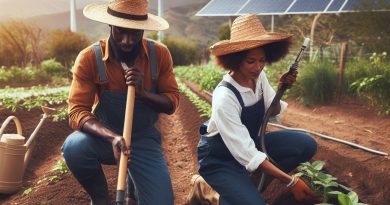Farming Adaptively: Diverse Crops in Focus
Last Updated on March 2, 2024
Introduction
Adaptive farming is an approach that allows farmers to respond to changing environmental conditions and market demands.
This method focuses on adjusting farming practices to optimize productivity and sustainability.
Brief explanation of adaptive farming
Adaptive farming involves making modifications to traditional farming techniques based on factors such as climate change, soil health, and pest management.
It aims to ensure long-term viability while minimizing negative environmental impacts.
Importance of diverse crops in adaptive farming
Diverse crops play a crucial role in adaptive farming as they enhance resilience and reduce vulnerability to climate change.
By cultivating a variety of crops, farmers can mitigate risks related to pests, diseases, and extreme weather events.
Additionally, diverse crops offer economic benefits by expanding market opportunities and reducing price volatility.
A diverse crop rotation system can help improve soil health, prevent nutrient depletion, and control weeds.
Different crop types act as natural pest deterrents, reducing the need for chemical pesticides.
Moreover, diverse crops facilitate a stronger ecosystem, promoting biodiversity and supporting beneficial insects and pollinators.
When growing diverse crops, farmers can also tap into niche markets and take advantage of consumer demands for specialty and heirloom varieties.
This diversification can lead to improved income stability and reduce reliance on a single crop.
In fact, adaptive farming and the cultivation of diverse crops are essential for sustainable agriculture.
By adopting these practices, farmers can adapt to environmental changes, enhance ecosystem services, and maximize profitability in an ever-evolving agricultural landscape.
Benefits of Diverse Crops in Adaptive Farming
Increasing resilience to climate change
Adaptive farming involves planting diverse crops that have varying tolerance to extreme weather conditions.
This diversity allows farmers to adapt to the shifting climate patterns and continue producing a successful harvest.
For example, if a particular crop is more resilient to drought, it can withstand periods of water scarcity and still produce a yield.
Diverse crops help buffer against crop failures
One of the greatest advantages of planting different crops is that it reduces the risk of total crop failure.
If a farmer relies solely on one crop and it fails due to disease, pests, or adverse weather conditions, the entire harvest is lost.
However, by diversifying the crops grown, if one crop fails, the others can still provide revenue and sustenance for the farmer.
Enhancing soil health and fertility
Different crops have different nutrient requirements.
By rotating diverse crops, farmers can prevent nutrient depletion and soil erosion.
Each crop takes different nutrients from the soil and leaves behind different residues, ensuring that the soil remains fertile and healthy.
Additionally, planting cover crops between main cash crops helps protect the soil from erosion and improves its overall structure.
Pest and disease management
When diverse crops are planted, pests and diseases are disrupted in their life cycles.
In monoculture farming, pests and diseases can easily spread throughout entire fields, causing devastating losses.
However, by intermixing various crops, pests and diseases encounter different barriers and struggle to establish sustained populations.
This reduces the need for chemical pesticides and fertilizers, promoting more sustainable and environmentally friendly farming practices.
Overall, the benefits of diverse crops in adaptive farming are significant.
By increasing resilience to climate change, farmers can better withstand unpredictable weather patterns.
Buffering against crop failures ensures a more secure food supply and economic stability for farmers.
Enhancing soil health and fertility through diverse crops promotes sustainable farming practices and protects the environment.
Lastly, pest and disease management is more effectively achieved when pests and diseases face disrupted life cycles.
By embracing diversity in farming, we can cultivate a more resilient and sustainable agricultural future.
Read: Climate Resilient Farming: Crop Diversity Key
Strategies for Incorporating Diverse Crops
Implementing diverse cropping systems is essential for sustainable and resilient agriculture.
By incorporating strategies such as crop rotation, intercropping, and cover cropping, farmers can optimize their land use, improve soil health, and enhance overall farm productivity.
Crop rotation
Crop rotation is a fundamental technique that involves growing different crops in a sequential order in the same field over several seasons.
This practice can break pest cycles, reduce weed pressure, and avoid nutrient depletion.
By alternating crops, farmers can effectively manage soil fertility and decrease the risk of diseases and pests that target particular crops.
For instance, planting legumes after cereal crops can replenish nitrogen levels and improve soil structure while mitigating the risk of soil-borne diseases.
Planning crop rotation cycles is crucial to maximize the benefits.
Farmers need to consider the nutrient requirements and growth characteristics of each crop.
They may also integrate cover crops into the rotation to protect the soil from erosion, suppress weeds, and provide additional organic matter.
An optimal crop rotation system could include alternating grains and legumes, or incorporating a fallow year with a cover crop to enhance soil health and nutrient cycling.
Intercropping
Intercropping is another effective strategy to diversify crops.
It involves growing different crops simultaneously in the same field.
Intercropping allows farmers to maximize space utilization, reduce pest pressure, and optimize resource use.
By combining tall and short crops or compatible plant species, farmers can utilize resources like sunlight, water, and nutrients more efficiently.
Additionally, intercropping can enhance biodiversity on the farm, attracting beneficial insects and improving pollination.
Common intercropping techniques include planting rows of nitrogen-fixing legumes alongside cash crops.
Legumes, such as clover or peas, enrich the soil with nitrogen, reducing the need for synthetic fertilizers.
Similarly, companion planting involves growing plants with different pest vulnerabilities together.
For example, certain plants may repel pests that would otherwise target the main crop.
Cover cropping
Cover cropping is the practice of planting non-harvested crops to cover the soil surface during periods when commercial crops are not growing.
Also, cover crops provide numerous benefits, including weed suppression, moisture retention, and soil enrichment.
They can also prevent erosion and nutrient leaching.
Farmers can choose cover crops based on their specific goals, such as fixing nitrogen, improving soil structure, or suppressing diseases.
There are several types of cover crops, each with unique benefits.
Legumes, like clover or vetch, fix atmospheric nitrogen, enhancing soil fertility for subsequent crops.
Grasses, such as rye or oats, create dense cover that suppresses weeds and prevents erosion.
Additionally, brassicas, like mustard or radishes, have biofumigant properties, suppressing soil-borne diseases and pests.
By implementing strategies like crop rotation, intercropping, and cover cropping, farmers can build resilience in their farming systems.
Diverse crops systems can improve soil health, reduce the reliance on external inputs, and mitigate the negative environmental impacts of monoculture farming.
Moreover, incorporating diverse crops can result in enhanced economic stability through diversified incomes and reduced vulnerability to market fluctuations.
In short, adopting strategies to incorporate diverse crops is essential for sustainable and adaptive agriculture.
Crop rotation, intercropping, and cover cropping are effective techniques that improve soil health, maximize resource utilization, and optimize farm productivity.
By implementing these practices, farmers can create resilient farming systems that are beneficial for both the environment and their own livelihoods.
Read: Beating Climate Change with Crop Choices

Explore Further: Water-Saving Innovations in Farming
Sustainable Farming Practices for Diverse Crop Systems
Organic farming techniques are essential for sustainable crop systems.
Avoiding synthetic inputs helps maintain soil health and protect the environment.
Promoting soil health through composting and natural fertilizers enhances crop productivity.
Conservation agriculture techniques minimize soil disturbance and erosion, preserving the soil’s quality.
Promoting biodiversity through crop diversification reduces the risk of pests and diseases.
Precision agriculture technologies revolutionize crop management with data-driven approaches.
Utilizing data-driven approaches streamlines farming operations and enhances crop productivity.
Optimizing resource use and reducing environmental impacts are key objectives of precision agriculture.
Organic Farming Techniques
Organic farming is a sustainable approach that rejects synthetic chemicals and focuses on natural methods.
Also, organic farmers promote biodiversity, soil health, and ecological balance through their practices.
They use compost, manure, and other natural fertilizers to nourish the soil and enhance crop growth.
Avoiding synthetic inputs like pesticides and herbicides ensures the safety of the environment and consumers.
Organic farming minimizes environmental pollution by reducing the use of chemical fertilizers and pesticides.
By avoiding genetically modified organisms (GMOs), organic farming maintains the integrity of the crops.
Conservation Agriculture
Conservation agriculture aims to protect the soil’s quality and minimize erosion.
Reducing soil disturbance through minimum tillage practices prevents soil erosion and preserves its structure.
Crop residue retention improves soil fertility, enhances water retention, and helps control weeds.
Conservation agriculture promotes crop rotation and cover crops to prevent nutrient depletion and soil erosion.
By reducing the use of heavy agricultural machinery, conservation agriculture minimizes soil compaction.
Conservation agriculture enhances the soil’s capacity to sequester carbon, contributing to climate change mitigation.
Precision Agriculture Technologies
Precision agriculture utilizes cutting-edge technologies to improve farm management and optimize crop production.
Remote sensing, GPS, and drones are used to monitor crop health, detect pests, and identify irrigation needs.
Data-driven decisions help farmers apply inputs precisely, minimizing waste and environmental impacts.
Variable rate technology optimizes the use of fertilizers, water, and other resources based on crop needs.
Real-time monitoring systems provide farmers with accurate information for timely interventions and decision-making.
Precision agriculture technologies enable farmers to adapt and respond to varying field conditions effectively.
Sustainable farming practices for diverse crop systems are crucial for preserving the environment and ensuring food security.
By adopting organic farming techniques, farmers can promote biodiversity, soil health, and consumer well-being.
Conservation agriculture techniques contribute to sustainable land management, mitigating soil erosion and nutrient depletion.
Precision agriculture technologies revolutionize farming by optimizing resource use and improving crop management.
As agriculture faces the challenges of feeding a growing population while protecting the planet, these practices are key to a sustainable future.
Read: Crops & Climate: Diversifying for Adaptation
Challenges and Considerations
Market demand and profitability
Assessing consumer preferences and market trends is vital for farmers looking to farm adaptively with diverse crops.
It is essential to understand what consumers want and what is currently in demand in the market.
By identifying consumer preferences, farmers can determine which diverse crops have the potential to be profitable.
Market research and analysis are crucial in this process.
Farmers may need to consult with experts, attend trade shows, or conduct surveys to gather information about consumer preferences.
Understanding market trends is also crucial to stay ahead of the competition and adapt farming practices accordingly.
Knowledge and expertise
Adaptively farming diverse crops requires farmers to continuously learn and enhance their skills and knowledge.
Traditional farming practices might not be suitable for all diverse crops, and farmers need to stay updated with the latest farming techniques and technologies.
Continuous training programs and workshops can help farmers gain the necessary expertise in cultivating diverse crops.
Collaborating with agricultural extension services and experts can also provide valuable guidance and knowledge.
By staying informed and educated, farmers can improve their chances of success in adaptively farming diverse crops.
Infrastructure and storage facilities
Having adequate infrastructure and storage facilities is vital for ensuring the proper handling and storage of diverse crops.
Different diverse crops have varying storage requirements, and farmers need to meet these requirements to maintain the quality of the harvested crops.
Investing in appropriate storage facilities such as cold storage units or drying facilities can help preserve the quality and prolong the shelf life of diverse crops.
Farmers should also invest in proper handling equipment to minimize damage during transportation and storage.
Addressing logistical challenges
Marketing and distributing diverse crops can present logistical challenges for farmers.
Diverse crops might have specific market channels and distribution networks that need to be considered and established.
Collaborating with local agricultural cooperatives or engaging with distributors can help farmers overcome these challenges.
Efficient transportation systems and reliable logistics partners are essential for ensuring the timely delivery of diverse crops to the market.
In essence, adaptively farming diverse crops comes with its own set of challenges and considerations.
Farmers need to assess market demand and profitability, continuously learn and enhance their expertise, invest in appropriate infrastructure and storage facilities, and address logistical challenges for successful farming of diverse crops.
Read: Climate Smart: Embracing Crop Diversity
Conclusion
Diverse crops in adaptive farming offer numerous benefits.
They enhance soil health, reduce pest and disease risks, and ensure a stable income for farmers.
Therefore, it is essential for farmers to embrace diversification in their farming practices.
By growing a variety of crops, they can mitigate the impacts of climate change and market fluctuations.
Additionally, collaboration and knowledge sharing play a crucial role in sustainable agriculture.
Farmers should actively engage with other farmers, scientists, and experts to exchange ideas and learn from each other’s experiences.
By working together, farmers can discover innovative techniques and strategies to improve their farming practices while safeguarding the environment and ensuring food security for future generations.
Overall, embracing diverse crops, collaborating with others, and sharing knowledge are key elements for successful and sustainable adaptive farming.


